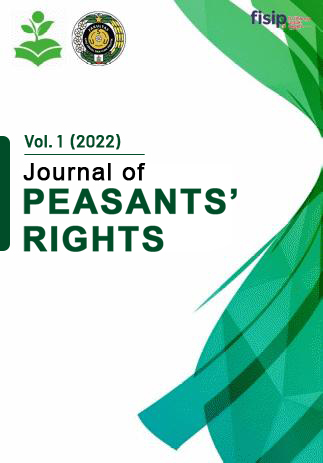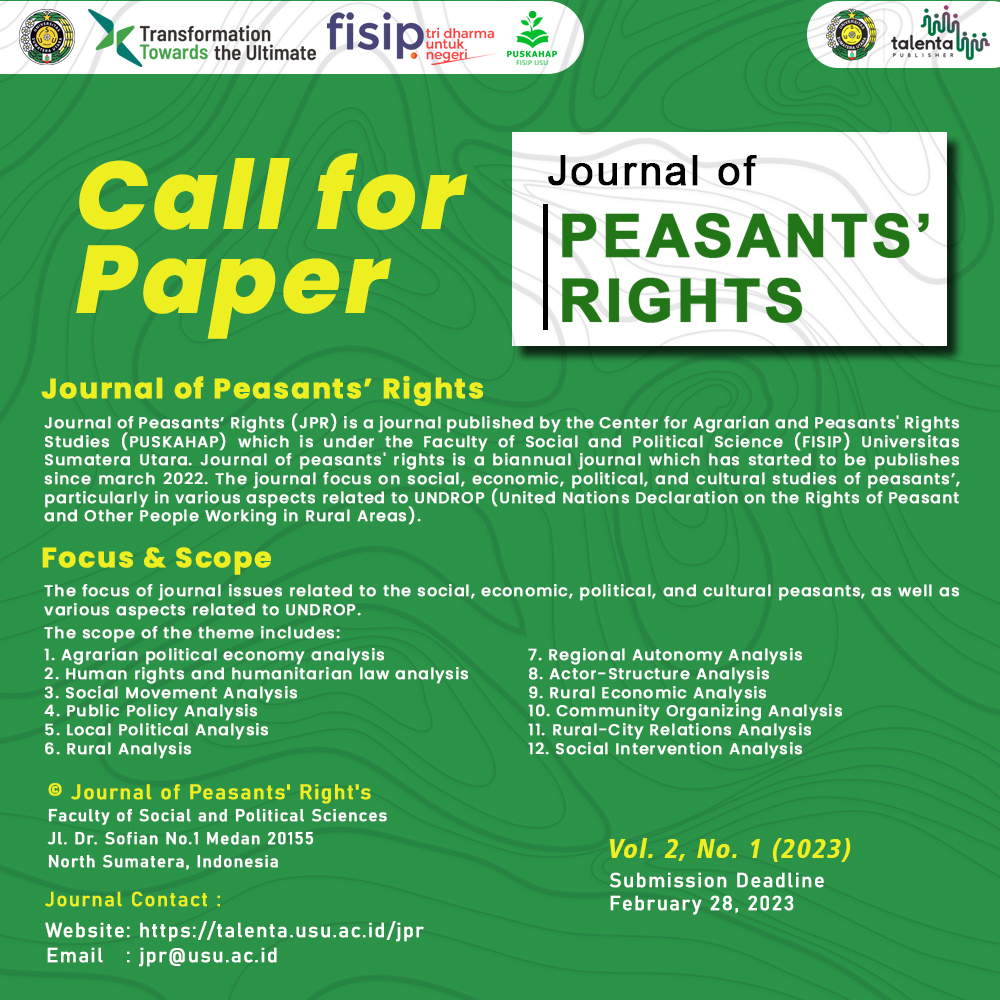Community Intervention in Sustainable Food Yard Program for Women Farmer Group in Tigo Koto Diate Village, Indonesia
DOI:
https://doi.org/10.32734/jpr.v2i1.12109Keywords:
Community Intervention, Women Farmer Group, Social ProgramAbstract
This research investigated how community interventions are implemented by the Food Security Agency through the Sustainable Food Yard Program for the Dahlia Sakato Women Farmer Group. This study describes the implementation of Community interventions in 12 variables using a qualitative approach. Based on the results of the research and analysis performed to examine the community intervention model, it is possible to infer that this program is a type of intervention with the Capacity Development with Substantial Planning / Policy model. This is based on a program practice strategy that develops competencies through pre-planned actions. This study also suggests that future studies look at the program's long-term impact as an endeavor to establish food sovereignty.
Downloads
References
Adi, Isbandi Rukminto. 2013. Intervensi Komunitas & Pengembangan Masyarakat Sebagai Upaya Pemberdaya Masyarakat. Jakarta: PT RajaGrafindo Persada.
Agarwal, B. (2010). Rethinking agricultural production collectivities. Economic and Political Weekly, 64-78.
Cote, M., & Nightingale, A. J. (2012). Resilience thinking meets social theory: situating social change in socio-ecological systems (SES) research. Progress in human geography, 36(4), 475-489.
Dolinska, A., & d'Aquino, P. (2016). Farmers as agents in innovation systems. Empowering farmers for innovation through communities of practice. Agricultural systems, 142, 122-130.
Graeub, B. E., Chappell, M. J., Wittman, H., Ledermann, S., Kerr, R. B., & Gemmill-Herren, B. (2016). The state of family farms in the world. World development, 87, 1-15.
GarcÃa Guerrero, J. E., Rueda López, R., Luque González, A., & Ceular-Villamandos, N. (2021). Indigenous peoples, exclusion and precarious work: design of strategies to address poverty in indigenous and peasant populations in Ecuador through the SWOT-AHP methodology. International Journal of Environmental Research and Public Health, 18(2), 570.
Hirway, I., & Jose, S. (2011). Understanding women's work using time-use statistics: The case of India. Feminist Economics, 17(4), 67-92.
Ismail, A., Mohamed, H. A. B., Sulaiman, A. Z., Mohamad, M. H., & Yusuf, M. H. (2011). An empirical study of the relationship between transformational leadership, empowerment and organizational commitment. Business and Economics Research Journal, 2(1), 89.
Jones, G. J., Edwards, M. B., Bocarro, J. N., Bunds, K. S., & Smith, J. W. (2018). Leveraging community sport organizations to promote community capacity: Strategic outcomes, challenges, and theoretical considerations. Sport Management Review, 21(3), 279-292.
Jost, C., Kyazze, F., Naab, J., Neelormi, S., Kinyangi, J., Zougmore, R., ... & Kristjanson, P. (2016). Understanding gender dimensions of agriculture and climate change in smallholder farming communities. Climate and Development, 8(2), 133-144.
Laverack, G., & Labonte, R. (2000). A planning framework for community empowerment goals within health promotion. Health policy and planning, 15(3), 255-262.
Marston, G., & McDonald, C. (2012). Getting beyond ‘heroic agency’in conceptualising social workers as policy actors in the twenty-first century. British Journal of Social Work, 42(6), 1022-1038.
Melandani, R. (2021). Efektivitas Program Optimalisasi Pemanfaatan Lahan Perkarangan Melalui Kelompok Wanita Tani Di Kecamatan Seberida Kabupaten Indragiri Hulu (Doctoral dissertation, Universitas Islam Riau).
Moleong, L. J. (2017). Metode penelitian kualitatif, Bandung: PT. Remaja Rosda Karya.
Mudege, N. N., Nyekanyeka, T., Kapalasa, E., Chevo, T., & Demo, P. (2015). Understanding collective action and women's empowerment in potato farmer groups in Ntcheu and Dedza in Malawi. Journal of Rural Studies, 42, 91-101.
Novita, I. (2022). PERAN KELOMPOK WANITA TANI (KWT) DALAM PROGRAM PEKARANGAN PANGAN LESTARI DI KECAMATAN BOGOR SELATAN KOTA BOGOR. JURNAL AGRIBISAINS, 8(2), 82-88.
Quisumbing, A. R., & Pandolfelli, L. (2010). Promising approaches to address the needs of poor female farmers: Resources, constraints, and interventions. World development, 38(4), 581-592.
Ragasa, C., Ulimwengu, J., Randriamamonjy, J., & Badibanga, T. (2016). Factors affecting performance of agricultural extension: Evidence from Democratic Republic of Congo. The Journal of Agricultural Education and Extension, 22(2), 113-143.
Ramdani, J. (2020). INTERVENSI KOMUNITAS BERBASIS GREEN SOCIAL WORK. Jurnal Obor Penmas: Pendidikan Luar Sekolah, 3(2), 270-277.
Rojikinnor, R. (2020). Organizational commitment and professionalism of State Civil Apparatus to determine public satisfaction through good governance, public service quality and public empowerment. Journal of Social and Economic Development, 22, 401-413.
Rothman, J. (1995). Approaches to community intervention. Strategies of community intervention, 5, 26-63.
Rothman, J. (2007). Multi modes of intervention at the macro level. Journal of Community Practice, 15(4), 11-40.
Toomey, A. H. (2011). Empowerment and disempowerment in community development practice: eight roles practitioners play. Community Development Journal, 46(2), 181-195.
Uduji, J. I., Okoloâ€Obasi, E. N., & Asongu, S. A. (2019). Corporate social responsibility and the role of rural women in sustainable agricultural development in subâ€Saharan Africa: Evidence from the Niger Delta in Nigeria. Sustainable Development, 27(4), 692-703.
Zubaedi, M. A. (2016). Pengembangan masyarakat: wacana dan praktik. Jakarta: Pustaka Kencana.







